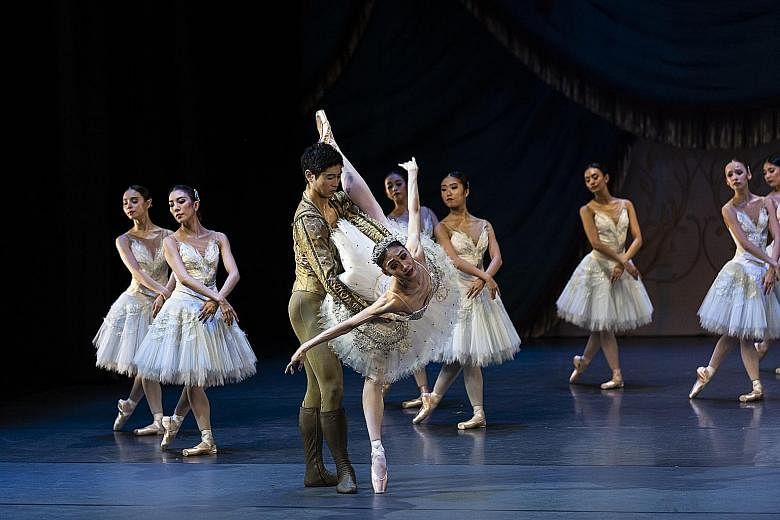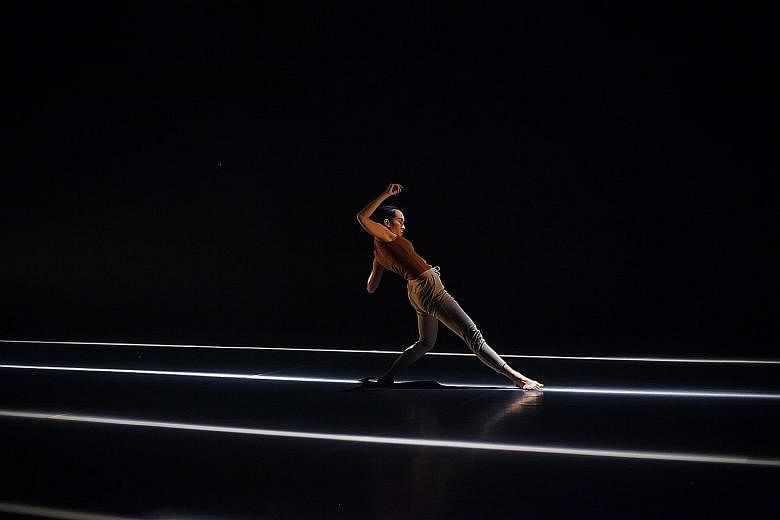SWAN LAKE
Singapore Dance Theatre
Esplanade Theatre
Last Friday, 8pm (Cast B) Sunday, 7pm (Cast A)
Singapore Dance Theatre (SDT) first presented this canonic work from the classical ballet repertoire in 2007 and this staging of Swan Lake reveals how much the company has grown since then.
The iconic entrance of the corps de ballet at the beginning of Act II was breathtaking. Unlike earlier stagings where students were included in the corps, this was danced solely by company artists or apprentices.
The corps moved as one, precise and light, with beautiful arms and epaulement. The swans were expressive in every scene, capturing the sadness underlying their dance, even as they executed tidy footwork.
In this impressive production, the company opted to deviate from the traditional classical pancake tutu for the cast of white swans. Instead, the swans were dressed in knee-length soft tutus, draping over the legs to cover the thighs.
This appeared awkward at first, but the flowing skirts did lend the swans a more ethereal quality that was a fresh touch.
In the courtly scenes, the men shone in leaping and turning sequences, displaying ballon and precision, in spite of some wobbly landings. The joyful, festive dances were pulled off with aplomb.
Mimetic scenes carrying the narrative forward were thoroughly delightful, with great chemistry among the dancers.
Kana Minegishi and Kwok Min Yi both made their debuts in the role of Odette/Odile.
Minegishi started off tentative as Odette, but in Act III as Odile, she took on the character with more confidence. She brought to the character of the black swan an air that is at once feisty and sinister, and her fouettes in the muchanticipated Act III coda were executed with confidence.
Kwok commanded the stage with spine-tingling emotional strength. With each extension of the leg and each dive into a lift, the audience forgot the dancer and saw Odette, or Odile.
In her interpretation, the iciness of Odette was surprising yet convincing. As Odile, she looked out into audiences as if to address them; her incredible charisma filling the stage with a magnetic force.
It would be great to see her perform in the lead roles of neoclassical and contemporary ballets, where her strength and precision will be further displayed.
Since last year, SDT has partnered Metropolitan Festival Orchestra. The presence of live music brought the ballet experience to a whole other level of enjoyment.
The orchestra was excellent, although it seemed at times that its pace pushed the dancers to rush through sequences.
As the companies continue their partnership and the performers work together, the intimate relationship between music and dance will surely become more breathtakingly stunning.
Emerging choreographers shine in incubation programme
LITHE 2019
T.H.E. Second Company
School of the Arts/Nov 22
This was the third and final iteration of a choreographic incubation programme for emerging choreographers Goh Shou Yi, Anthea Seah and Marcus Foo.
The three former T.H.E. Second Company members collaborated with current Second Company dancers and artists from other disciplines to produce three pieces.
Cross-disciplinary collaboration resulted in the inspired piece Gaps, where a soloist cradled a small speaker, muffling and exposing the sound created by Ng Jing, allowing the fluctuations in volume to echo her movements as she made her fluid progress across the stage.
The dance, choreographed by Goh, had a multiplicity of clever but disjointed ideas, such as the rustling of plastic dresses and colourful post-it notes fluttering off a dancer's dress.
These contributed to the overall sensory experience, but combined to create confusion.
With the magical lighting design by Liu Yong Huay, Quietly She Treads, choreographed by Seah, took on a hypnotic quality, amplified by the dancers' intense focus as they sensed the folding of one another's bodies and reacted to the soft crinkling of their paper-like costumes.
Foo was the only one of the three choreographers who kept with his idea over the three iterations, and it showed. This Is How We Meet/Part - Phase 3 was the most cohesive of the three dances.
Dancers flitted between disappearing pools of light that led them on pathways on and off stage.
They were drawn towards and away from one another in a continuous cycle, broken by a particularly arresting solo by Zeng Yu that was both quirky and sinuous.
The dances in liTHE 2019 may be incomplete, but they augur well for future works from these promising choreographers.
Dance at a glance
PASSAGES
Singapore Dance Theatre
Esplanade Theatre Studio/Nov 2
Alongside a trio of restaged works at Singapore Dance Theatre's annual contemporary dance season Passages, sits an effervescent oddity. This is Australian choreographer Lucas Jervies' new creation, titled Family Reunion.
The piece cheekily replaced the decorum of ballet with the swagger of disco dancing as legs were flung into the air and sequins caught the light.
Yayoi Matches, in particular, was a revelation, the gentleness in her movement belying a soulful strength.
SPEAKING WITH HANDS
Diverse Abilities Dance Company
The ArtGround/Nov 7
This was a full-house debut for Kavitha Krishnan's new Diverse Abilities Dance Company. Company members from the Down Syndrome Association and Maya Dance Theatre performed simple and exuberant works with an Indian classical flair.
The largely ensemble pieces did not always show off the individual creativity and unique qualities of the performers, but there is potential to see more as the company grows.
JOURNEY TO A DREAM
Part of the Southernmost Festival
Emergency Stairs
Centre 42 Black Box/Nov 8
Journey is co-directed by long-time collaborators Liu Xiaoyi and Danny Yung - bringing together the two artistic directors' previous explorations.
The work was performed by seven artists from across Asia, each with experience in a different form, such as classical Javanese dance, classical Cambodian dance and kunqu opera. Beautiful, lyrical moments throughout the work evidenced the performers' mastery of their respective forms.
Although the Southernmost Festival aims to challenge boundaries among form, performer and audience, Journey maintained the conventional relationship between performer and audience.
The art forms remained distant to those who are not "insiders" to the form.
HELLO, HOW DO YOU MOVE?
Rachel Nip and Ammar
Practice Tuckshop/Nov 16
Disability is no barrier to communication or dancing for hearing contemporary dancer Rachel Nip and deaf street dancer Ammar.
Their differences and similarities were the basis for this light-hearted and enjoyable site-specific duet.
The duo responded to the intimate space playfully, perching on tables, speaking into corners and squeezing into window frames. The audience was then invited to join in, to change its perspective, listen to the vibration of surfaces and participate in the dancing. This work was created to be accessible to deaf audiences as well as hearing audiences.
It is a raw work with a promising premise for further development.
MARABU - THE FIRST RIPPLE
Bhaskar's Arts Academy, Suvarna Fine Arts (Malaysia), Avant Theatre and Gamelan Singamurti
Esplanade Theatre Studio/Nov 17
Marabu - The First Ripple is the first part of a trilogy conceptualised and choreographed by Cultural Medallion recipient Santha Bhaskar.
The performance started by following the life of a peasant and traced the development of the Indian community in South-east Asia. It was directed by G. Selva and co-choreographed by Ajith Bhaskar.
Although billed as dance-theatre, it would be better described as a dance and drama, with the two forms mostly alternating on stage.
Marabu unfolded a meandering tale that attempted to pack hundreds of years of history into 11/2 hours, making for a thin plot that dragged the pacing down.
The highlight of the performance was the dances. Performers swiftly appeared to emphasise the action, set the context and create the atmosphere.
They danced with energy and grace, morphing from a raging sea to sculptors gradually revealing the curving figures on temple walls, transporting the audience between time and place.
Chan Sze Wei, Germaine Cheng, Jocelyn Chng, Bernice Lee and Melissa Quek




